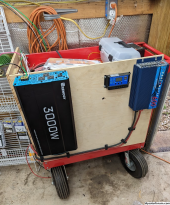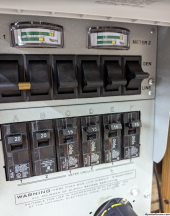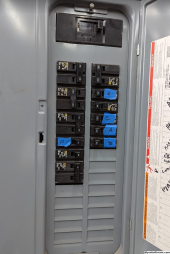I have not said much about my setup, it is in my shop and runs "most" things in the shop. I have this inverter, the small old one is just a backup. I actually don't even have it anymore I gave it to the in laws so next time they loose power for a week they can open the garage door and keep a fridge running for at least long enough to keep things from going bad. A fridge will hold its temp quite well if you leave the door closed.

I have it hooked up to this manual transfer panel. It is currently 120 only and the double breaker in the pic has now been split to just do 120.

Hooked into a "normal" panel. The tape letters go with what circuit is on the panel. This is why I say "most" things are on it.

The things that are not on it that I am thinking about is the 240 stuff. Some of these are high current like welders and plasma cutters. I will not run those off "battery", but I would really like to run the A/C. Perhaps the lift. I also want to power the barn, there are just some LED's in there for light, not many and several battery tenders for the mowers and tractors. This is on a 240 "feeder" to the barn from the panel showed above.
Now for the hard part.....I think, I want to stay 12v. I want to do this for several reasons, but the big one is availability of....stuffs. 12v stuff is everywhere, most campers have it, most motorhomes have it. And if the day comes when I can't find things and the internet is gone, I think 12v is going to be more easy to come by. I just want to stay this way, I think I have an understanding on the shortcomings of the 12v.
To just be clear, I am not a person doing this to "save the planet", I am doing this so I have power when the people on the planet start to act really nutty if you catch my drift.
My setup is also on this rolling Harbor Freight cart, currently 9 batteries, more from when these old photos are taken. This way I can roll it into the house and power things like the fridge freezers and all that jazz. There are also "medical" needs that require power. In a SHTF type deal people will not do well with no power.
I hope I explained that well.

I have it hooked up to this manual transfer panel. It is currently 120 only and the double breaker in the pic has now been split to just do 120.

Hooked into a "normal" panel. The tape letters go with what circuit is on the panel. This is why I say "most" things are on it.

The things that are not on it that I am thinking about is the 240 stuff. Some of these are high current like welders and plasma cutters. I will not run those off "battery", but I would really like to run the A/C. Perhaps the lift. I also want to power the barn, there are just some LED's in there for light, not many and several battery tenders for the mowers and tractors. This is on a 240 "feeder" to the barn from the panel showed above.
Now for the hard part.....I think, I want to stay 12v. I want to do this for several reasons, but the big one is availability of....stuffs. 12v stuff is everywhere, most campers have it, most motorhomes have it. And if the day comes when I can't find things and the internet is gone, I think 12v is going to be more easy to come by. I just want to stay this way, I think I have an understanding on the shortcomings of the 12v.
To just be clear, I am not a person doing this to "save the planet", I am doing this so I have power when the people on the planet start to act really nutty if you catch my drift.
My setup is also on this rolling Harbor Freight cart, currently 9 batteries, more from when these old photos are taken. This way I can roll it into the house and power things like the fridge freezers and all that jazz. There are also "medical" needs that require power. In a SHTF type deal people will not do well with no power.
I hope I explained that well.


